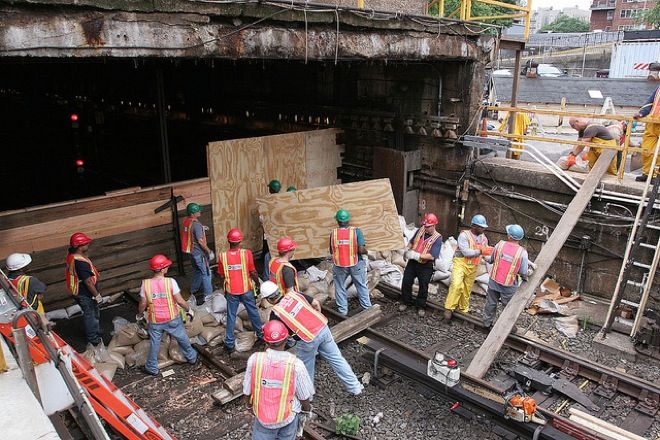August is a typical lull in the amphetaminized 24-hour news cycle. People go on vacation, Congress adjourns to their vacation homes in Maine, and big media outlets squeeze stories out of stone and wear the tread out of international intrigue until the events lose traction. Things stateside were typically subdued in the waning days of summer—that is until Irene came around.
Hurricane Irene had a lot of monikers thrown at it, all of them with a similar tone: this storm was going to be once-in-a-generation bad. Cities were evacuated, surfers were arrested, and panic was widespread. The nation kept an especially focused eye on New York’s preparations in a city that has seen less than a dozen major storms since 1821. Hurricane Irene was billed as “different” in New York City and a cautionary tenor dominated conversations regarding what city officials needed to do with the more than 8 million residents.
As Irene lurched towards New York it was obvious that the Bloomberg administration was taking a better-safe-than-sorry approach to storm logistics. Surges and flooding were already wreaking havoc in hurricane-seasoned states down the Eastern seaboard and New York, suddenly surrounded by menacing waters, had to act.
Act it did, evacuating over 300,000 people in the low-lying areas of Brooklyn and Manhattan and shutting down public transportation for nearly 48 hours ahead of the impending squall. The partial evacuation left more than enough people in the city to fill up bars capitalizing on storm-themed drinks and parties, but the dangers, at least in the minds of city officials and armchair meteorologists, were tangible enough to warrant serious action.
Hurricane Irene came and went and while the damage in New York City will climb north of $1 billion (and potentially $20 billion nationally), the estimates made by statistical gurus like the Times’ Nate Silver can now be safely decried as paranoid (it should be noted that Mr. Silver’s dollar-damage estimates were based on hurricanes in general, not Irene specifically). The real damage as we now know is in states like New Jersey and Vermont where, for various reasons, water and wind decimate infrastructure on a scale unknown in New York. What we are left with is a simple question: did New York overreact to Hurricane Irene?
The Bloomberg Administration’s decision to evacuate 300,000 people from flood-prone zones was an extreme one and put the city’s internal emergency management skills to a stress test. Fortunately, the question of overreaction or not is particularly relevant; loss of life and property in New York could have been substantially worse with even a marginal increase in Irene’s momentum. The two main symptoms of Mayor Bloomberg’s emergency strategy—evacuations and infrastructure closures—weren’t actually that surprising or novel. Those moves served as a bulwark—or perhaps a hedge— against local and national condemnation for underestimating Mother Nature, something that Mayor Bloomberg knows well from last year’s disastrous blizzard—or as the always-understated Post calls it “Mike’s Katrina moment.”
The storm, while not as powerful as predicted the days prior to its landfall in New York, did bring more than 7 inches of rain, drowning infrastructure and bringing surges into parts of Battery Park and the Rockaways. “Zone A” residents, as they’re called by New York City’s evacuation plan, faced everything from fallen trees to power downs. Some in the lowlands, in the words of the New Yorker’s Kate Rouhandeh, were left “hoping for the appearance of an ark.” when Sunday afternoon came and the windows in the Empire State Building weren’t shattered and tour buses hadn’t been blown away in the gale, there was a collective chuckle at the panic in City Hall. Cynicism drove the conversation this week, as if the calculus of destruction has to be an equation rather than an inequality to satisfy all comers.
Mayor Bloomberg and his advisors may have paid too much attention to media outlets looking for a story with an Armageddon-lite patina to it, but there are two facts that people skirt in favor of a better story: the storm was among the ten costliest in the country’s history, and New York got hit hard, just not as hard as it could have. As New Yorkers counted up the damage in dollar figures there was a mixture of relief and comedy—hyperbole gave way to sober assessment and a healthy dose of sarcasm. And the Bloomberg administration, guilty of smashing a cockroach with the Encyclopedia Britannica, started to clean up what they thought was going to be the storm of the century, knowing that it did what it could to simply make it the storm of the year.
















